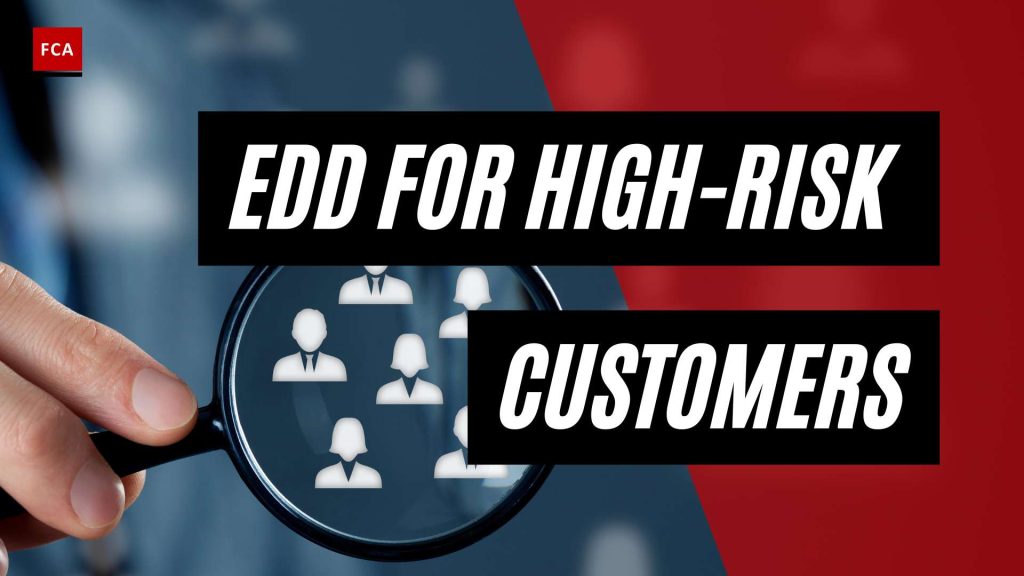Understanding Enhanced Due Diligence (EDD)
Enhanced Due Diligence (EDD) is a critical component of anti-money laundering (AML) compliance that involves an advanced risk assessment process to identify and mitigate potential financial crimes like money laundering, corruption, and terrorist financing. It goes beyond standard due diligence procedures to provide a deeper understanding of customers and their associated risks.
What is Enhanced Due Diligence?
Enhanced Due Diligence (EDD) refers to a set of measures designed to assess customers based on their risk profiles, safeguarding against crimes like money laundering, corruption, and terrorist financing. It involves an in-depth analysis of customers’ backgrounds, transactions, and business relationships. By conducting EDD, organizations can gain a comprehensive understanding of their customers and identify any potential red flags or suspicious activities.
EDD procedures typically involve gathering and verifying additional information beyond what is required in standard due diligence. This may include obtaining more detailed customer identification data, assessing the source of funds, and analyzing the purpose of transactions. By implementing EDD, organizations can better assess the risks associated with their customers and make informed decisions regarding business relationships.
Importance of EDD in Compliance
Enhanced Due Diligence (EDD) plays a crucial role in addressing the challenges posed by financial crimes. By conducting thorough EDD assessments, organizations can identify high-risk customers and transactions, reducing the likelihood of being involved in illicit activities. EDD helps organizations meet their regulatory obligations and enhances their overall compliance efforts.
By implementing a risk-based approach to EDD, organizations can allocate their resources more effectively and focus on high-risk areas. This allows for a more efficient and targeted application of due diligence measures, ensuring that efforts are concentrated where they are most needed. Compliance with regulatory requirements, such as those set forth by the Financial Action Task Force (FATF), is essential for organizations to maintain a strong AML program and prevent potential legal and reputational risks.
In summary, Enhanced Due Diligence (EDD) is an integral part of AML compliance, enabling organizations to identify and manage risks associated with customers and transactions. By adopting a risk-based approach and implementing robust EDD measures, organizations can enhance their ability to prevent financial crimes and adhere to regulatory expectations.
Risk-Based Approach to EDD
Enhanced Due Diligence (EDD) is a crucial component of anti-money laundering (AML) compliance. Implementing a risk-based approach to EDD allows organizations to focus their resources where they are most needed, ensuring that due diligence efforts are tailored to the level of risk presented by customers and transactions. This section will explore the introduction, benefits, and implementation of a risk-based approach to EDD.
Introduction to Risk-Based Approach
A risk-based approach to EDD involves conducting assessments to identify and mitigate risks associated with business relationships and transactions, rather than applying a uniform process to all customers (KYC Hub). By categorizing customers into different risk levels, organizations can allocate resources more efficiently and focus on the areas where risks are most significant.
Benefits of a Risk-Based Approach
Adopting a risk-based approach to EDD offers several benefits. Firstly, it allows for a more targeted identification of potential money laundering, fraud, or reputational risks. By focusing resources where they are most needed, organizations can effectively combat financial crimes while reducing the burden on low-risk customers (KYC Hub).
Secondly, a risk-based approach enables organizations to allocate resources more efficiently. By categorizing customers into different risk levels, organizations can apply corresponding levels of due diligence, ensuring that higher-risk relationships and transactions receive greater scrutiny. This approach ensures that resources are allocated based on the level of risk, optimizing operational efficiency (KYC Hub).
Implementing a Risk-Based Approach
To implement a risk-based approach to EDD, organizations should follow a structured process. This includes defining risk factors, establishing risk levels, and developing EDD procedures for different risk categories. By doing so, organizations can ensure consistent risk management and mitigate potential risks effectively.
When defining risk factors, organizations should consider various elements such as customer characteristics, transactional patterns, and geographic locations. These factors help determine the level of risk associated with each customer or transaction. Once risk factors are identified, organizations can establish risk levels, such as low, medium, and high, based on the level of risk exposure.
After categorizing customers and transactions into risk levels, organizations can then develop EDD procedures tailored to each level. These procedures will outline the specific due diligence measures to be applied, such as the depth of customer verification and ongoing monitoring requirements. This systematic approach ensures that EDD efforts are proportionate to the level of risk and compliance requirements.
Implementing a risk-based approach to EDD is not only encouraged by regulators but also considered a best practice within the industry. By adopting this approach, organizations can enhance overall compliance and effectiveness in combating financial crimes, while also optimizing resource allocation for better operational efficiency.
In the next section, we will explore how organizations can conduct EDD assessments to identify risk factors and establish risk levels for effective risk-based EDD procedures.
Conducting EDD Assessments
To effectively implement an enhanced due diligence (EDD) program, organizations must conduct thorough assessments to identify and mitigate risks associated with their business relationships and transactions. By adopting a risk-based approach to EDD, organizations can tailor their efforts to focus on higher-risk areas, ensuring a more efficient allocation of resources. This section explores the key steps involved in conducting EDD assessments: identifying risk factors, establishing risk levels, and developing EDD procedures.
Identifying Risk Factors
When conducting EDD assessments, it is essential to identify and evaluate the risk factors that may be present in a customer or transaction. These risk factors can vary depending on the industry, jurisdiction, and specific circumstances. Some common risk factors to consider include:
- High-risk jurisdictions or countries with weak regulatory frameworks.
- Customers with complex ownership structures, such as offshore companies or trusts.
- Politically exposed persons (PEPs) or individuals with close associations to PEPs.
- Unusual or suspicious transaction patterns.
- Non-profit organizations or charities operating in high-risk areas.
- Customers involved in industries prone to money laundering or terrorist financing, such as casinos or cash-intensive businesses.
By understanding these risk factors, organizations can better assess the potential risks associated with each customer or transaction, enabling them to implement appropriate EDD measures.
Establishing Risk Levels
Once the risk factors have been identified, organizations can establish risk levels for their customers. This categorization allows for a more targeted and risk-based approach to EDD. Typically, risk levels are determined based on the level of inherent risk posed by a customer or transaction.
Organizations may use a risk rating system, such as low, medium, or high, or assign numerical values to indicate the risk level. The specific criteria for determining risk levels may vary depending on the organization’s risk appetite and industry regulations. The risk level assessment should consider factors such as the customer’s industry, geographic location, transaction volume, and the presence of any red flags identified during the initial due diligence process.
By categorizing customers into different risk levels, organizations can allocate appropriate resources and apply corresponding levels of due diligence, focusing more attention on higher-risk customers and transactions.
Developing EDD Procedures
Once risk levels have been established, organizations can develop EDD procedures tailored to the different risk categories. These procedures should outline the specific steps and measures that need to be taken for each risk level. Key components of EDD procedures may include:
- Enhanced customer verification processes, such as obtaining additional identification documents or conducting more in-depth background checks.
- Enhanced transaction monitoring, including closer scrutiny of high-value transactions or those involving high-risk jurisdictions.
- Ongoing monitoring of customer activity to detect and investigate any suspicious behavior or changes in risk profile.
- Regular reviews and updates of customer risk assessments to ensure continued compliance with evolving regulations and changes in risk exposure.
By implementing robust EDD procedures, organizations can effectively mitigate the risks associated with higher-risk customers and transactions, safeguarding against financial crimes, money laundering, and terrorist financing.
A risk-based approach to EDD is not only encouraged by regulators but also considered a best practice within the industry. It enhances overall compliance and effectiveness in combating financial crimes (KYC Hub). By conducting thorough EDD assessments, organizations can gain a comprehensive understanding of their customers and transactions, enabling them to implement appropriate risk mitigation measures and ensure compliance with regulatory requirements.
In the next section, we will explore EDD measures and procedures in more detail, including customer categorization, tailored due diligence efforts, and consistent risk management.
EDD Measures and Procedures
Implementing effective measures and procedures is essential when conducting Enhanced Due Diligence (EDD). By categorizing customers, tailoring due diligence efforts, and consistently managing risks, organizations can enhance their compliance efforts and mitigate potential risks.
Customer Categorization
When applying a risk-based approach to EDD, organizations categorize customers into different risk levels based on their potential risk factors. These risk factors can include factors such as geographic location, nature of the business, transactional behavior, and reputation (KYC Hub). By categorizing customers, organizations can allocate appropriate levels of due diligence efforts based on the assessed risk level.
To effectively categorize customers, organizations should establish clear criteria for each risk level. This may involve conducting a comprehensive risk assessment that takes into account both internal and external factors. By considering these factors, organizations can accurately determine the level of risk associated with each customer and tailor their due diligence efforts accordingly.
Tailored Due Diligence Efforts
A risk-based approach to EDD allows organizations to tailor their due diligence efforts to match the identified risk level of each customer. Higher-risk customers require more extensive due diligence measures, while lower-risk customers may require less stringent procedures. This approach ensures that resources are allocated efficiently, focusing efforts where they are most needed (KYC Hub).
Tailored due diligence efforts may include conducting more thorough background checks, verifying the source of funds, reviewing additional documentation, and performing enhanced ongoing monitoring. By customizing the level of due diligence based on risk, organizations can effectively identify and mitigate potential risks associated with each customer.
Consistent Risk Management
Consistency in risk management is crucial for maintaining an effective EDD process. Organizations should establish clear procedures and methodologies for conducting EDD and ensure that these processes are consistently applied across the organization. This consistency helps to minimize the risk of overlooking or under-assessing potential risks.
Consistent risk management involves regularly reviewing and updating risk assessments, monitoring changes in risk factors, and adjusting due diligence efforts accordingly. By maintaining a proactive approach to risk management, organizations can adapt to evolving risks and regulatory requirements.
When it comes to EDD, a risk-based approach is not only encouraged by regulators and industry best practices, but it is also crucial for enhancing overall compliance and effectiveness in combating financial crimes (KYC Hub). By categorizing customers, tailoring due diligence efforts, and consistently managing risks, organizations can strengthen their AML compliance measures and protect themselves from potential risks.
To learn more about EDD regulations and requirements, as well as other aspects of EDD, please refer to our EDD regulations and requirements article.
Compliance and Effectiveness
To ensure effective AML compliance and combat financial crimes, it is essential to meet regulatory expectations and follow industry best practices for Enhanced Due Diligence (EDD).
Regulatory Expectations
Regulators emphasize the importance of a risk-based approach to EDD in assessing potential risks associated with each customer or transaction. By applying this approach, companies can gather relevant information based on the level of risk posed by a particular client or transaction, allowing for more targeted due diligence efforts (KYC Hub).
Regulatory bodies expect organizations to implement a risk-based approach to EDD as part of their compliance framework. This approach involves categorizing customers into risk levels and employing appropriate due diligence procedures based on these risk levels. By tailoring efforts to high-risk areas, organizations can enhance the effectiveness of their due diligence processes and overall compliance efforts.
Industry Best Practices
In addition to regulatory expectations, industry best practices also emphasize the importance of a risk-based approach to EDD. By adopting this approach, organizations can allocate their resources efficiently, focusing on higher-risk areas. This targeted approach allows for more effective risk management and compliance efforts, ensuring that due diligence procedures are applied where they are most needed (KYC Hub).
Industry experts recommend that organizations establish comprehensive EDD procedures and methodologies to ensure consistency in risk management and compliance. It is crucial to continually assess and update these procedures to keep up with evolving regulatory requirements and emerging risks. By doing so, organizations can stay ahead of potential threats and safeguard compliance with anti-money laundering (AML) regulations (KYC Hub).
By aligning with regulatory expectations and adopting industry best practices, organizations can enhance the effectiveness of their EDD efforts. A risk-based approach not only enables organizations to focus their resources on higher-risk areas but also ensures that due diligence procedures are tailored to the specific risks associated with each customer or transaction. This approach promotes better compliance outcomes and strengthens the overall AML framework of an organization.
EDD for High-Risk Customers
When it comes to enhanced due diligence (EDD), one of the key focuses is on high-risk customers. These customers are typically associated with a higher likelihood of engaging in money laundering or other illicit activities. Implementing robust EDD measures is crucial for financial institutions to identify and mitigate these risks effectively.
Identifying High-Risk Individuals
Identifying high-risk individuals is an essential step in the EDD process. Financial institutions utilize various indicators and risk factors to determine whether a customer falls into this category. These risk factors can include factors such as:
-
Politically Exposed Persons (PEPs): PEPs are individuals who hold prominent public positions or have close associations with influential public figures. Due to their potential vulnerability to corruption, PEPs are considered high-risk customers.
-
Adverse Media and Negative Reputation: Financial institutions monitor public sources of information to identify any adverse media or negative reputation associated with a customer. This can include news articles, regulatory actions, or other public records that may indicate potential involvement in illegal activities.
-
Unusual Transaction Patterns: Unexplained, complex, or unusually large transactions can be indicative of money laundering or other illicit activities. Financial institutions closely analyze customer transactions to identify any suspicious patterns that warrant further scrutiny.
By leveraging risk-based approaches, financial institutions can effectively identify and categorize high-risk individuals, allowing them to allocate appropriate resources and implement stringent EDD measures.
Scrutinizing Suspicious Transactions
In addition to identifying high-risk individuals, financial institutions also scrutinize suspicious transactions as part of their EDD efforts. This involves closely monitoring customer transactions and conducting thorough analysis to identify any red flags or indicators of illicit activity.
Financial institutions employ advanced transaction monitoring systems and analytical tools to detect unusual or suspicious patterns. These systems utilize algorithms and artificial intelligence to analyze vast amounts of data and identify potentially suspicious transactions. Suspicious transactions can include:
-
Structuring: Transactions deliberately broken down into smaller amounts to avoid reporting thresholds and detection.
-
Rapid Movement of Funds: Large sums of money transferred rapidly between accounts or jurisdictions without a clear business rationale.
-
Transactions Involving High-Risk Jurisdictions: Transactions with counterparties or jurisdictions known for high levels of corruption, money laundering, or terrorist financing.
By scrutinizing suspicious transactions, financial institutions can identify potential risks and take appropriate action, such as filing a suspicious activity report (SAR) with the relevant authorities, as required by regulatory requirements for EDD.
In conclusion, conducting EDD for high-risk customers is a critical component of an effective AML compliance program. By identifying high-risk individuals and scrutinizing suspicious transactions, financial institutions can mitigate the risks associated with money laundering and other illicit activities. Implementing robust EDD measures ensures compliance with regulatory expectations and helps protect the integrity of the financial system.
EDD Process in Banking
Within the banking industry, the Enhanced Due Diligence (EDD) process plays a vital role in ensuring compliance with KYC (Know Your Customer) regulations and mitigating the risk of financial crimes. This section will explore the relationship between KYC compliance and EDD, the importance of gathering detailed information, and managing high-risk relationships.
KYC Compliance and EDD
KYC compliance serves as the foundation for the EDD process in banking. It involves verifying the identity of customers and assessing the risks associated with their financial activities. EDD takes the KYC process further by implementing additional measures to scrutinize high-risk customers and transactions, ensuring compliance with anti-money laundering (AML) regulations and preventing illicit activities (Idenfy).
By conducting a thorough KYC process, banks can gather essential information about their customers, including personal identification details, financial history, and the purpose of the banking relationship. This information serves as the basis for determining the level of due diligence required and identifying potential red flags that may indicate higher risks.
Gathering Detailed Information
To perform effective EDD, banks must gather detailed information about their customers. This includes but is not limited to:
- Customer identification documents, such as passports or national identification cards
- Proof of address, like utility bills or bank statements
- Employment details and sources of income
- Financial statements and transaction history
- Business ownership structure and beneficial ownership information
By obtaining this information, banks can assess the legitimacy of the customer’s financial activities, identify any potential risks associated with money laundering or terrorist financing, and comply with regulatory requirements (Sanction Scanner).
Managing High-Risk Relationships
One of the key aspects of the EDD process in banking is managing high-risk relationships. High-risk customers are individuals or entities that pose a greater risk in terms of potential involvement in illicit activities or compliance concerns (Idenfy). Identifying and effectively managing these relationships is crucial to mitigate risks and maintain regulatory compliance.
Once a high-risk relationship is identified, banks must implement additional risk management measures. This may include more frequent monitoring of transactions, enhanced transactional analysis, and ongoing due diligence to ensure that the customer’s activities remain consistent with their expected behavior. Regular reviews and updates of customer information are also necessary to stay abreast of any changes that may impact the risk profile.
By actively managing high-risk relationships, banks can minimize the potential for financial losses, reputational damage, and legal penalties. It allows them to detect and prevent suspicious activities and maintain robust AML and EDD processes.
In summary, the EDD process in banking is a critical component of KYC compliance, involving gathering detailed information about customers and managing high-risk relationships. By implementing thorough EDD measures, banks can better assess the risks associated with their customers’ financial activities and ensure compliance with regulatory requirements. This approach helps protect the integrity of the banking system and contributes to the overall fight against financial crimes.
Technology-Driven EDD Solutions
In the realm of AML compliance, technology plays a crucial role in enhancing the effectiveness and efficiency of Enhanced Due Diligence (EDD) processes. By leveraging advanced risk intelligence algorithms and comprehensive data sources, technology-driven EDD solutions offer valuable tools to identify and mitigate risks associated with high-risk customers and transactions.
Advanced Risk Intelligence Algorithms
Technology-driven EDD solutions, such as those offered by Sanction Scanner, employ advanced risk intelligence algorithms to analyze vast amounts of data and identify potential risks. These algorithms can automatically flag transactions, individuals, or entities that exhibit suspicious patterns or characteristics. By applying these algorithms, compliance professionals can streamline EDD measures, enhance risk assessments, and reduce the likelihood of compliance violations.
The use of risk intelligence algorithms enables companies to automate the initial screening process, allowing for a more efficient and accurate identification of high-risk customers. By leveraging technology to analyze data in real-time, organizations can stay abreast of emerging risks and adapt their EDD procedures accordingly.
Comprehensive Data Sources
Comprehensive data sources are a vital component of technology-driven EDD solutions. These sources provide access to a wide range of information, including adverse media, negative control lists, politically exposed persons (PEPs) lists, and other relevant data. By utilizing these comprehensive data sources, compliance professionals can gather valuable insights about customers and transactions, enabling them to make informed decisions and conduct thorough risk assessments.
The ability to access and integrate multiple data sources into EDD procedures allows organizations to gain a holistic view of the risks associated with their customer base. This comprehensive approach ensures that potential red flags or risk indicators are not overlooked, helping to safeguard compliance efforts.
By leveraging advanced risk intelligence algorithms and comprehensive data sources, technology-driven EDD solutions empower organizations to enhance their risk management capabilities and strengthen their compliance measures. These solutions enable compliance professionals to efficiently identify high-risk customers and transactions requiring additional scrutiny, streamlining EDD measures and reducing the likelihood of compliance violations.
The Role of Risk-Based Approach in Regulatory Compliance
In the realm of regulatory compliance, adopting a risk-based approach plays a crucial role in ensuring effective and efficient compliance measures. This approach tailors efforts to high-risk areas, allowing for the allocation of resources where they are most needed and enabling organizations to prioritize their compliance efforts. By focusing on areas of highest potential risk, organizations can streamline their processes, save time and money, and enhance overall compliance effectiveness.
Tailoring Efforts to High-Risk Areas
A risk-based approach to regulatory compliance involves identifying areas with the highest potential risk to public health, safety, or other regulatory concerns. Instead of applying the same level of scrutiny to all aspects of a product or process, organizations concentrate their efforts on areas that pose the greatest threat. This targeted approach allows for a more thorough examination of critical areas, ensuring that compliance measures are appropriately tailored to address specific risks.
By focusing on high-risk areas, organizations can identify potential vulnerabilities and areas of improvement. This risk assessment provides valuable insights that inform decision-making and resource allocation, allowing organizations to prioritize their compliance efforts where they are needed most. In doing so, organizations can enhance their ability to detect and mitigate risks, ensuring that regulatory requirements are met in areas that have the greatest impact on public safety and quality (LinkedIn).
Efficient Resource Allocation
One of the key advantages of a risk-based approach is the efficient allocation of resources. By focusing on high-risk areas, organizations can concentrate their resources, saving time and money in the compliance process. This targeted allocation allows for a more comprehensive examination of critical areas, ensuring that compliance measures are effectively implemented.
Efficient resource allocation also enables organizations to adapt swiftly to changing regulatory requirements and evolving risks. By directing resources to areas with the highest potential impact, organizations can stay ahead of regulatory updates and proactively address emerging risks. This adaptability is particularly important in the life science industry, where regulations and risks can evolve rapidly.
Furthermore, by efficiently allocating resources, organizations can enhance their overall compliance effectiveness and maintain a strong reputation. By focusing on areas of highest risk, organizations can improve the quality of their products or services, benefiting customers and safeguarding their reputation (LinkedIn).
In the context of Enhanced Due Diligence (EDD), a risk-based approach allows organizations to tailor their efforts to high-risk customers, scrutinizing their activities and transactions more closely. By allocating resources efficiently, organizations can effectively manage high-risk relationships and mitigate the potential risks associated with them.
In summary, a risk-based approach in regulatory compliance ensures that efforts are tailored to high-risk areas, allowing for efficient resource allocation. By focusing on areas with the highest potential risk, organizations can enhance their compliance effectiveness, adapt to evolving regulatory requirements, and safeguard their reputation.
EDD in the Life Science Industry
The life science industry recognizes the importance of adopting a risk-based approach to Enhanced Due Diligence (EDD) in order to adapt swiftly to regulatory updates and evolving risks while ensuring compliance. This industry encompasses various sectors such as pharmaceuticals, biotechnology, medical devices, and more, where compliance with anti-money laundering (AML) regulations is crucial to maintain integrity and safeguard public health.
Adapting to Regulatory Updates
In the ever-evolving landscape of regulations, the life science industry faces continuous changes that impact compliance requirements. By implementing a risk-based approach to EDD, organizations in this industry can proactively adapt to regulatory updates and stay ahead of compliance obligations. This approach allows them to identify and address potential vulnerabilities, ensuring that their compliance efforts align with the latest regulations and guidelines.
Adapting to regulatory updates involves conducting regular assessments of risks associated with money laundering, fraud, and other financial crimes. By staying informed about regulatory changes and incorporating them into their risk assessment processes, life science companies can effectively mitigate the risk of non-compliance and ensure the integrity of their operations.
Safeguarding Compliance
Safeguarding compliance is a primary goal for organizations in the life science industry. By incorporating a risk-based approach to EDD, companies can identify high-risk areas and allocate resources efficiently to address those areas. This ensures that compliance efforts are focused on areas that pose the greatest risk, allowing for a more thorough examination of critical aspects.
Compliance in the life science industry goes beyond AML regulations. It encompasses a wide range of requirements, including but not limited to, data privacy, patient safety, clinical trials, and product quality. By integrating risk assessment into their compliance strategy, organizations can gain valuable insights into potential vulnerabilities and areas for improvement. This leads to improved decision-making that prioritizes safety, quality, and ethical conduct.
Moreover, a risk-based approach to EDD enables organizations to allocate resources effectively. By concentrating resources where they are needed most, companies can save time and money while maintaining a robust compliance program. This efficient resource allocation ensures that compliance efforts are proportionate to the level of risk, allowing organizations to meet regulatory expectations and safeguard their reputation.
As the life science industry continues to evolve, a risk-based approach to EDD is essential for organizations to adapt to regulatory updates, safeguard compliance, and maintain the highest standards of integrity and quality. By prioritizing risk assessment and incorporating it into their compliance strategies, companies can navigate the complex regulatory landscape with confidence and meet the ever-changing demands of the industry.
The Value of Risk-Based Approach
Implementing a risk-based approach to enhanced due diligence (EDD) offers several valuable benefits to organizations. It allows them to focus their efforts on areas of highest potential risk, which ultimately leads to improved product quality and reputation protection.
Improving Product Quality
A risk-based approach to regulatory compliance enables organizations to tailor their efforts, directing resources and attention to areas where non-compliance poses the greatest threat to public health and safety. By concentrating resources on critical areas, companies can identify potential vulnerabilities and areas of improvement more effectively (LinkedIn). This method allows for a more thorough examination of these critical areas, leading to improved decision-making that prioritizes safety and quality.
By incorporating risk assessments into their compliance strategies, organizations gain valuable insights into their processes and products. This knowledge helps them identify weaknesses and areas where improvements are needed. By addressing these areas, companies can enhance their product quality, ensuring that they meet the required standards and regulations.
Protecting Reputation
In today’s interconnected world, reputation is of utmost importance. A risk-based approach plays a crucial role in safeguarding an organization’s reputation. By focusing on areas of highest risk, companies can address potential compliance issues before they harm their reputation. This proactive approach demonstrates a commitment to compliance and responsible business practices.
Adopting a risk-based approach also allows organizations to adapt swiftly to regulatory updates and evolving risks, particularly in industries like the life sciences. Shifting regulations can present challenges, but with a risk-based approach, companies can ensure compliance even in the face of changing requirements (LinkedIn). By staying ahead of regulatory changes and maintaining a strong compliance posture, organizations can protect their reputation and maintain the trust of their stakeholders.
In conclusion, a risk-based approach to EDD offers significant value to organizations. By improving product quality and safeguarding reputation, companies can enhance their compliance efforts and demonstrate their commitment to responsible business practices. By continually assessing and addressing areas of highest potential risk, organizations can ensure that they meet regulatory requirements and maintain the trust of their customers and stakeholders.
Regulatory Requirements for EDD
In order to effectively combat money laundering and terrorist financing, regulatory bodies have established specific requirements for Enhanced Due Diligence (EDD). These requirements aim to ensure that businesses and financial institutions implement robust measures to identify and mitigate risks associated with their customers and transactions.
Financial Action Task Force (FATF) Guidelines
The Financial Action Task Force (FATF), an intergovernmental organization focused on combating money laundering and terrorist financing, provides guidelines for EDD implementation. According to the FATF, member countries must implement Customer Due Diligence (CDD) measures, which include conducting EDD, for business relationships and transactions involving natural and legal persons and financial institutions from countries designated by the FATF as high-risk (ComplyAdvantage).
The FATF emphasizes the need for a risk-based approach to determine the extent of EDD measures required. This means that organizations should assess the level of risk associated with each customer and transaction and tailor their EDD efforts accordingly. The risk assessment process should take into account factors such as the customer’s jurisdiction, the nature of the business relationship, and the purpose and intended nature of the transaction.
Recordkeeping and Reporting Obligations
Regulatory requirements for EDD also include recordkeeping and reporting obligations. Businesses and financial institutions are typically required to maintain records of the information obtained during the EDD process for a minimum period of five years. These records may include identification documents, business documentation, and any additional information relevant to the risk assessment.
Furthermore, firms are obligated to promptly report any suspicious activities to their jurisdiction’s financial intelligence unit. This is typically done through the submission of a Suspicious Activity Report (SAR). The SAR aims to provide authorities with information that may be indicative of money laundering or terrorist financing activities. By reporting suspicious activities, businesses and financial institutions play a crucial role in supporting efforts to combat financial crimes.
Compliance with regulatory requirements for EDD is essential for businesses and financial institutions to demonstrate their commitment to preventing money laundering and terrorist financing. By adhering to the guidelines and implementing effective EDD measures, organizations can enhance their ability to identify and mitigate the risks associated with their customers and transactions, ultimately contributing to a more secure and transparent global financial system.








